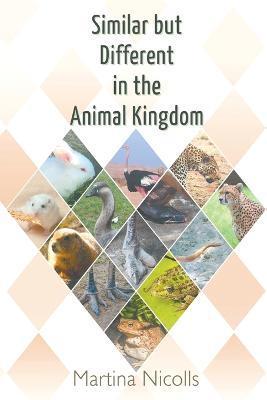Similar but Different in the Animal Kingdom

Similar but Different in the Animal Kingdom
Similar but Different in the Animal Kingdom is an educational science book for everyone-children, youth, schools, libraries, and anyone interested in animals. Learn about the similarities and differences among twenty-five sets of animals: bees and wasps, frogs and toads, gophers and hamsters, falcons and hawks, herons and storks, ants and termites, donkeys and mules, and more.
What are the similarities and differences between alligators and crocodiles? Which one has a U-shaped snout, and which one has a V-shaped snout? What are the similarities and differences between fleas and ticks? Which one is not an insect? Are wallabies just small kangaroos? Emus and ostriches are similar because they can't fly, but they have different feet. Which one has two toes and which one has three? Salmon and tuna have different tails, whereas octopuses and squids have the same number of hearts.
Butterflies and moths have different antennae. Which one has club-shaped antennae and which one has feathery antennae? Can cheetahs or leopards climb trees, and which one can't roar? Do dolphins and porpoises have similar dorsal fins? Do foxes and wolves have more similarities or more differences? Similar but Different in the Animal Kingdom has the answers!
This intriguing look at the animal kingdom provides "Fast Facts" with an instant list of the animals' main similarities and differences, as well as their scientific classifications, descriptions, habitats, diets, breeding habits, and much more. There are interesting facts, fallacies, phrases, singular and plural animal words, collective nouns, and a glossary of scientific terms.
Martina Nicolls holds a master's degree in science communication and is interested in animal conservation.
Publisher's website: http: //sbpra.com/MartinaNicolls
PRP: 228.16 Lei
Acesta este Pretul Recomandat de Producator. Pretul de vanzare al produsului este afisat mai jos.
205.34Lei
205.34Lei
228.16 LeiIndisponibil
Descrierea produsului
Similar but Different in the Animal Kingdom is an educational science book for everyone-children, youth, schools, libraries, and anyone interested in animals. Learn about the similarities and differences among twenty-five sets of animals: bees and wasps, frogs and toads, gophers and hamsters, falcons and hawks, herons and storks, ants and termites, donkeys and mules, and more.
What are the similarities and differences between alligators and crocodiles? Which one has a U-shaped snout, and which one has a V-shaped snout? What are the similarities and differences between fleas and ticks? Which one is not an insect? Are wallabies just small kangaroos? Emus and ostriches are similar because they can't fly, but they have different feet. Which one has two toes and which one has three? Salmon and tuna have different tails, whereas octopuses and squids have the same number of hearts.
Butterflies and moths have different antennae. Which one has club-shaped antennae and which one has feathery antennae? Can cheetahs or leopards climb trees, and which one can't roar? Do dolphins and porpoises have similar dorsal fins? Do foxes and wolves have more similarities or more differences? Similar but Different in the Animal Kingdom has the answers!
This intriguing look at the animal kingdom provides "Fast Facts" with an instant list of the animals' main similarities and differences, as well as their scientific classifications, descriptions, habitats, diets, breeding habits, and much more. There are interesting facts, fallacies, phrases, singular and plural animal words, collective nouns, and a glossary of scientific terms.
Martina Nicolls holds a master's degree in science communication and is interested in animal conservation.
Publisher's website: http: //sbpra.com/MartinaNicolls
Detaliile produsului











